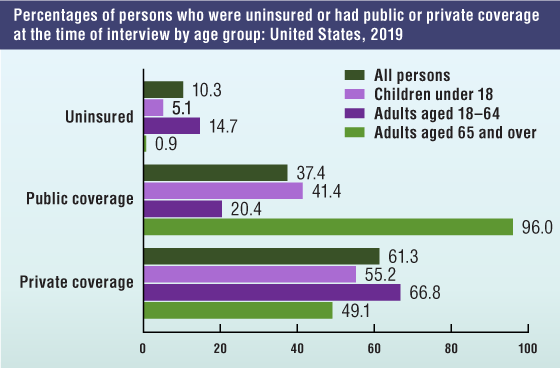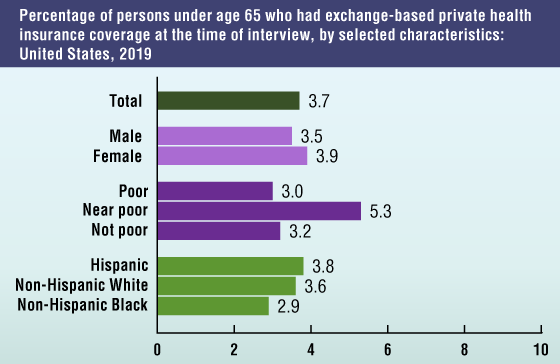NCHS Health Insurance Data
NCHS Fact Sheet, November 2020
About NCHS
The National Center for Health Statistics (NCHS) is the nation’s principal health statistics agency, providing data to identify and address health issues. NCHS compiles statistical information to help guide public health and health policy decisions.
Collaborating with other public and private health partners, NCHS uses a variety of data collection mechanisms to obtain accurate information from multiple sources. This process provides a broad perspective on the population’s health, influences on health, and health outcomes.
Health insurance
Health insurance coverage is an important determinant of access to health care and health status. Uninsured children and nonelderly adults are substantially less likely than their insured counterparts to have a usual source of health care or a recent health care visit. The major source of coverage for persons under age 65 is private employer-sponsored group health insurance. Individual and family private health insurance coverage can also be purchased either directly or through the Health Insurance Marketplace or state-based exchanges. Public programs, such as Medicaid and the Children’s Health Insurance Program, provide coverage for many low-income children and adults.
To develop policies and programs that improve health insurance coverage, it is important to obtain timely and accurate information on the number of persons who lack health insurance coverage and the number of persons with different types of coverage.
Health insurance data
The National Health Interview Survey (NHIS) has been collecting comprehensive data on health insurance coverage since 1959. Estimates on the percentage uninsured, with public coverage, or with private coverage at the time of the interview are provided on a quarterly basis. Data are also provided on enrollment through the Health Insurance Marketplace and state-based exchanges. In January 2019, NHIS launched a redesigned questionnaire. The new design collects health insurance information from one randomly selected adult and child from each household in the survey.
- In 2019, 14.7% of adults aged 18–64 were uninsured at the time of the interview, 20.4% had public coverage, and 66.8% had private health insurance coverage.
- In 2019, 5.1% of children aged 0–17 years were uninsured, 41.4% had public coverage, and 55.2% had private health insurance coverage.

NOTES: Persons were defined as uninsured if they did not have any private health insurance, Medicare, Insurance Program (CHIP), state-sponsored or other government plan, or military plan. Persons were also defined as uninsured if they had only Indian Health Service coverage or had only a private plan that paid for one type of service, such as accidents or dental care. Public coverage includes Medicaid, CHIP, state-sponsored or other government-sponsored health plan, Medicare, and military plans. Private coverage includes any comprehensive private insurance plan (including health maintenance and preferred provider organizations). These plans include those obtained through an employer, purchased directly, purchased through local or community programs, or purchased through the Health Insurance Marketplace or a state-based exchange. Private coverage excludes plans that pay for only one type of service, such as accidents or dental care. A small number of persons were covered by both public and private plans and were included in both categories. Data are based on household interviews of a sample of the civilian noninstitutionalized population.
SOURCE: National Center for Health Statistics, National Health Interview Survey, 2019.
Additional selected NHIS findings from 2019 show:
- A total of 33.2 million persons of all ages (10.3%) were uninsured at the time of interview. In the second half of 2019, 35.7 million persons of all ages (11.0%) were uninsured—significantly higher than the first 6 months of 2019 (30.7 million, 9.5%).
- Among adults aged 18–64, Hispanic adults (29.7%) were more likely than non-Hispanic black (14.7%), non-Hispanic white (10.5%), and non-Hispanic Asian (7.5%) adults to be uninsured.
- Among adults aged 18–64, 4.4% (8.7 million) were covered by private health insurance plans obtained through the Health Insurance Marketplace or state-based exchanges.
- Among children aged 0–17 years, 5.1% were uninsured, 41.4% had public coverage, and 55.2% had private health insurance coverage.
- In 2019, among persons under age 65, 3.7% were covered by exchange-based coverage.
- Exchange-based coverage did not vary significantly by sex or race and ethnicity.
- Exchange-based coverage was higher among those who were near poor (5.3%) compared with those who were poor (3.0%) and those

NOTES: Poor persons were defined as those with incomes less than 100% of the federal poverty level (FPL); near-poor persons have incomes 100% to less than 200% of the FPL; not-poor persons have incomes that are 200% of the FPL or greater. Exchange-based coverage is a private health insurance plan purchased through the Health Insurance Marketplace or state-based exchanges that were established as part of the Affordable Care Act (ACA) of 2010 (P.L. 111–148, P.L. 111–152). Data are based on household interviews of a sample of the civilian noninstitutionalized population.
SOURCE: National Center for Health Statistics, National Health Interview Survey, 2019.
Health insurance data source
NHIS collects information on the health of the U.S. civilian noninstitutionalized population through personal household interviews. Topics include functioning and disability, selected conditions, health insurance coverage, health care access and use, and health-related behaviors.
For more information about NCHS, visit https://www.cdc.gov/nchs.
For more information about NHIS, visit https://www.cdc.gov/nchs/nhis.htm.